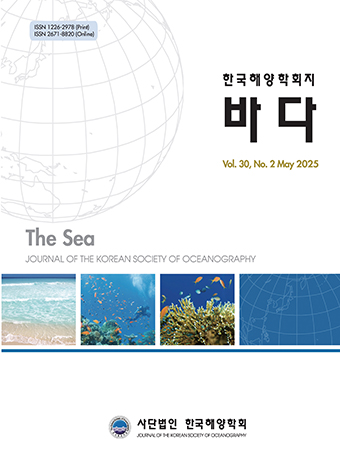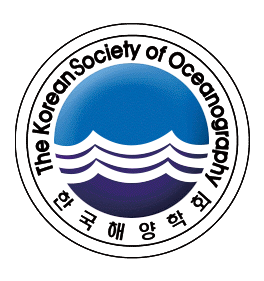Article
해양환경정보포털, 2023. Available at: https://meis.go.kr/mes/marineLife/protection/view1.do, Accessed: 15 December 2023.
Korea Marine Environment Management Corporation (KOEM), 2015. 외래해양생물 및 유해해양생물의 관리체계 개선방안 연구. 해양수산부. 137 pp. Available at: https://scienceon.kisti.re.kr/srch/selectPORSrchReport.do?cn=TRKO201700005032.
Bacher, S., T.M. Blackburn, F. Essl, P. Genovesi, J. Heikkilä, J.M. Jeschke, G. Jones, R. Keller, M. Kenis, C. Kueffer and A.F. Martinou, 2018. Socio‐economic impact classification of alien taxa (SEICAT). Methods Ecol. Evol., 9: 159-168.
10.1111/2041-210X.12844Bernardo-Madrid, R., P. González-Moreno, B. Gallardo, S. Bacher and M. Vilà, 2022. Consistency in impact assessments of invasive species is generally high and depends on protocols and impact types. NeoBiota, 76: 163-190.
10.3897/neobiota.76.83028Blackburn, T.M., F. Essl, T. Evans, P.E. Hulme, J.M. Jeschke, I. Kühn, S. Kumschick, Z. Marková, A. Mrugała, W. Nentwig and J. Pergl, 2014. A unified classification of alien species based on the magnitude of their environmental impacts. PLoS Bio., 12: e1001850.
10.1371/journal.pbio.100185024802715PMC4011680Blackburn, T.M., P. Pyšek, S. Bacher, J.T. Carlton, R.P. Duncan, V. Jarošík, J.R. Wilson and D.M. Richardson, 2011. A proposed unified framework for biological invasions. Trends Ecol. Evol., 26: 333-339.
10.1016/j.tree.2011.03.02321601306Canavan, S., L.A. Meyerson, J.G. Packer, P. Pyšek, N. Maurel, V. Lozano, D.M. Richardson, G. Brundu, K. Canavan, A. Cicatelli and J. Čuda, 2019. Tall-statured grasses: a useful functional group for invasion science. Biol. Invasions, 21: 37-58.
10.1007/s10530-018-1815-zChristie, A.P., T. Amano, P.A. Martin, G.E. Shackelford, B.I. Simmons and W.J. Sutherland, 2019. Simple study designs in ecology produce inaccurate estimates of biodiversity responses. J. Appl. Ecol., 56: 2742-2754.
10.1111/1365-2664.13499Essl, F., S. Bacher, P. Genovesi, P.E. Hulme, J.M. Jeschke, S. Katsanevakis, I. Kowarik, I. Kühn, P. Pyšek, W. Rabitsch and S. Schindler, 2018. Which taxa are alien? Criteria, applications, and uncertainties. BioScience, 68: 496-509.
10.1093/biosci/biy057Evans, T. and T.M. Blackburn, 2020. Global variation in the availability of data on the environmental impacts of alien birds. Biol. Invasions, 22: 1027-1036.
10.1007/s10530-019-02153-zFinch, D.M., J.L. Butler, J.B. Runyon, C.J. Fettig, F.F. Kilkenny, S. Jose, S.J. Frankel, S.A. Cushman, R.C. Cobb, J.S. Dukes and J.A. Hicke, 2021. Effects of climate change on invasive species. Polland et al. (Eds), Invasive Species in Forests and Rangelands of the United States: a Comprehensive Science Synthesis for the United States Forest Sector, Springer, Berlin (2021), pp.57-83.
10.1007/978-3-030-45367-1_4Fischhoff, B. and A.L. Davis, 2014. Communicating scientific uncertainty. Proc. Natl. Acad. Sci. U.S.A., 111: 13664-13671.
10.1073/pnas.131750411125225390PMC4183175González-Moreno, P., L. Lazzaro, M. Vilà, C. Preda, T. Adriaens, S. Bacher, G. Brundu, G.H. Copp, F. Essl, E. García-Berthou and S. Katsanevakis,2019. Consistency of impact assessment protocols for non-native species. NeoBiota, 44: 1-25.
Hawkins, C.L., S. Bacher, F. Essl, P.E. Hulme, J.M. Jeschke, I. Kühn, S. Kumschick, W. Nentwig, J. Pergl, P. Pyšek and W. Rabitsch, 2015. Framework and guidelines for implementing the proposed IUCN Environmental Impact Classification for Alien Taxa (EICAT). Divers. Distrib., 21: 1360-1363.
10.1111/ddi.12379International Union for Conservation of Nature (IUCN), 2016. Rules of procedure for IUCN Red List assessments 2017-2020, version 3.0. Approved by the IUCN SSC Steering Committee in September 2016.
International Union for Conservation of Nature (IUCN), 2020a. IUCN EICAT Categories and Criteria. The Environmental Impact Classification for Alien Taxa (EICAT): First edition. Gland, Switzerland and Cambridge, UK: IUCN. DOI: https://doi.org/10.2305/IUCN.CH.2020.05.en.
10.2305/IUCN.CH.2020.05.enInternational Union for Conservation of Nature (IUCN), 2020b. Guidelines for using the IUCN Environmental Impact Classification for Alien Taxa (EICAT) Categories and Criteria): First edition. Version 1.1. Gland, Switzerland and Cambridge, UK: IUCN.
Kim, K.Y., J.Y. Park, J.H. Chae and S. Sin, 2019. Development of the methods for controlling and managing the marine ecosystem disturbing and harmful organisms (Report No R&D 2013-0265). Chonnam National University, Korea. 959 pp. Available at: (in Korean) https://scienceon.kisti.re.kr/commons/util/originalView.do?cn=TRKO202000031207&dbt=TRKO&rn=.
Kumschick, S. and D.M. Richardson, 2013. Species‐based risk assessments for biological invasions: advances and challenges. Divers. Distrib., 19: 1095-1105.
10.1111/ddi.12110McGeoch, M.A., P. Genovesi, P.J. Bellingham, M.J. Costello, C. McGrannachan and A. Sheppard, 2016. Prioritizing species, pathways, and sites to achieve conservation targets for biological invasion. Biol. Invasions, 18: 299-314.
10.1007/s10530-015-1013-1Milanović, M., S. Knapp, P. Pyšek and I. Kühn, 2020. Trait-environment relationships of plant species at different stages of the introduction process. NeoBiota, 58: 55-74.
10.3897/neobiota.58.51655Nentwig, W., S. Bacher, P. Pyšek, M. Vilà and S. Kumschick, 2016. The generic impact scoring system (GISS): a standardized tool to quantify the impacts of alien species. Environ. Monit. Assess., 188: 1-13.
10.1007/s10661-016-5321-427129597Novoa, A., K. Dehnen-Schmutz, J. Fried and G. Vimercati, 2017. Does public awareness increase support for invasive species management? Promising evidence across taxa and landscape types. Biol. invasions, 19: 3691-3705.
10.1007/s10530-017-1592-0Probert, A.F., L. Volery, S. Kumschick, G. Vimercati and S. Bacher, 2020. Understanding uncertainty in the Impact Classification for Alien Taxa (ICAT) assessments. NeoBiota, 62: 387-405.
10.3897/neobiota.62.52010Richardson, D.M., P. Pyšek, M. Rejmanek, M.G. Barbour, F.D. Panetta and C.J. West, 2000. Naturalization and invasion of alien plants: concepts and definitions. Divers. Distrib., 6: 93-107.
10.1046/j.1472-4642.2000.00083.xRoy, H.E., W. Rabitsch, R. Scalera, A. Stewart, B. Gallardo, P. Genovesi, F. Essl, T. Adriaens, S. Bacher, O. Booy and E. Branquart, 2018. Developing a framework of minimum standards for the risk assessment of alien species. J. Appl. Ecol., 55: 526-538.
10.1111/1365-2664.13025Shackleton, R.T., D.M. Richardson, C.M. Shackleton, B. Bennett, S.L. Crowley, K. Dehnen-Schmutz, R.A. Estévez, A. Fischer, C. Kueffer, C.A. Kull, and E. Marchante, 2019. Explaining people's perceptions of invasive alien species: A conceptual framework. J. Environ. Manage., 229: 10-26.
10.1016/j.jenvman.2018.04.04530077400Spalding, M.D., H.E. Fox, G.R. Allen, N. Davidson, Z.A. Ferdaña, M.A.X. Finlayson, B.S. Halpern, M.A. Jorge, A.L. Lombana, S.A. Lourie and K.D. Martin, 2007. Marine ecoregions of the world: a bioregionalization of coastal and shelf areas. BioScience, 57: 573-583.
10.1641/B570707Srėbalienė, G., S. Olenin, D. Minchin and A. Narščius, 2019. A comparison of impact and risk assessment methods based on the IMO Guidelines and EU invasive alien species risk assessment frameworks. PeerJ, 7: e6965.
10.7717/peerj.696531218119PMC6563794United Nations Development Programme (UNEP), 2010. Strategic plan for biodiversity 2011-2020 and the Aichi targets. In Report of the Tenth Meeting of the Conference of the Parties to the Convention on Biological Diversity.
- Publisher :The Korean Society of Oceanography
- Publisher(Ko) :한국해양학회
- Journal Title :The Sea Journal of the Korean Society of Oceanography
- Journal Title(Ko) :한국해양학회지 바다
- Volume : 29
- No :2
- Pages :116-138
- Received Date : 2023-12-22
- Revised Date : 2024-04-20
- Accepted Date : 2024-05-03
- DOI :https://doi.org/10.7850/jkso.2024.29.2.116




 The Sea Journal of the Korean Society of Oceanography
The Sea Journal of the Korean Society of Oceanography








